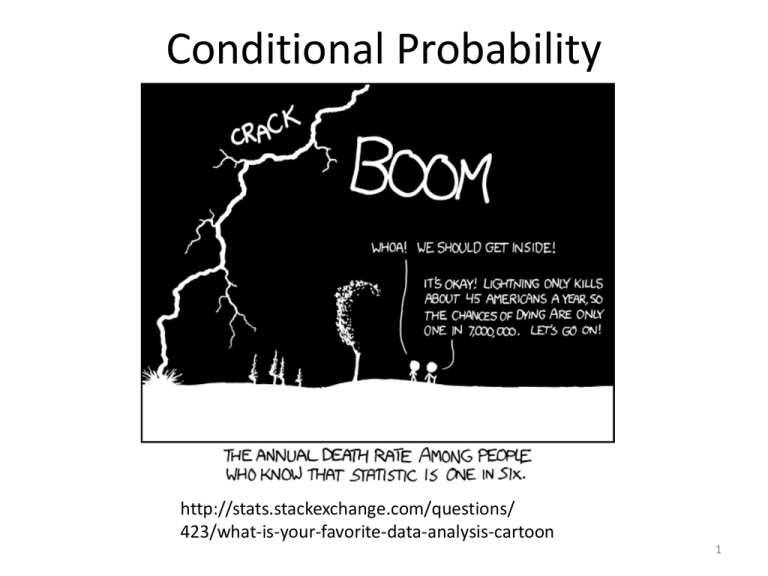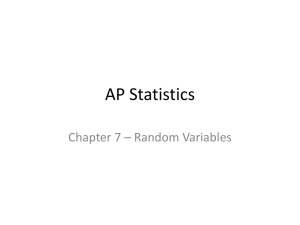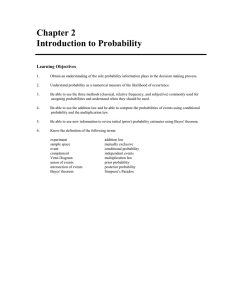Conditional Probability & Random Variables
advertisement

Conditional Probability http://stats.stackexchange.com/questions/ 423/what-is-your-favorite-data-analysis-cartoon 1 4.4/4.5: Conditional Probability and Independence - Goals • Be able to calculate conditional probabilities. • Apply the general multiplication rule. • Use Bayes rule (or tree diagrams) to find probabilities. • Determine if two events with positive probability are independent. • Understand the difference between independence and disjoint. 2 Formulas • Conditional Probability: 𝑃 𝐵𝐴 = 𝑃(𝐴∩𝐵) 𝑃(𝐴) • General multiplication rule: P(A ∩ B) = P(A) P(B|A) • Bayes’ Rule P B A P(A) P AB = P B A P A +P B A′ P(A′ ) 3 Law of Total Probability 1 4 3 B and 4 B and 3 5 6 B and 6 B and 7 2 7 B 4 Independence Two events are independent if knowing that one occurs does not change the probability that the other occurs. If A and B are independent: P(B|A) = P(B) P(A ∩ B) = P(A) P(B) 5 Disjoint vs. Independent In each situation, are the following two events a) disjoint and/or b) independent? 1) Draw 1 card from a deck A = card is a heart B = card is not a heart 2) Toss 2 coins A = Coin 1 is a head B = Coin 2 is a head 3) Roll two 4-sided dice. A = red die is 2 B = sum of the dice is 3 6 Chapter 5: Random Variables and Discrete Probability Distributions http://www.landers.co.uk/statistics-cartoons/ 7 5.1-5.2: Random Variables - Goals • Be able to define what a random variable is. • Be able to differentiate between discrete and continuous random variables. • Describe the probability distribution of a discrete random variable. • Use the distribution and properties of a discrete random variable to calculate the probability of an event. 8 Random Variables • A random variable is a function that assigns a unique numerical value to each outcome in a sample space. • Random variables can be discrete or continuous. • The probability distribution of a random variable gives its possible values and their probabilities. 9 Probability Distribution of a Random Variables • Probability mass function (pmf) is the probability that a discrete random variable is equal to some specific value. • In symbols, p(x) = P(X = x) • Properties 1. 0 ≤ pi ≤ 1 2. 𝑝𝑖 (𝑥) = 1 𝑖 10 Expected Value and Variance for Random Variables 𝐸 𝑋 = 𝜇 = 𝜇𝑋 = Var X = 𝜎 2 = 𝜎𝑋2 𝑥𝑖 𝑝𝑖 𝑖 = E X − 𝜇𝑋 2 = (𝑥𝑖 − X )2 ∙ 𝑝𝑖 = E(X2) – (E(X))2 𝜎𝑋 = 𝑉𝑎𝑟(𝑋) 11 Rules for Expected Value and Variance Means Rule 1: µa+bX = a + bµX Rule 2: µXY = µX µY Rule 3: 𝐸 𝑔 𝑋 = 𝑔 𝑥 𝑝(𝑥) Variance Rule 1: σ2a+bX = b2σ2X Rule 2: If X and Y are independent random variables, then: σ2XY = σ2X + σ2Y Rule 3: If X and Y have correlation ρ, then: σ2XY = σ2X + σ2Y 2ρσXσY 12





